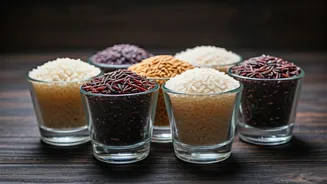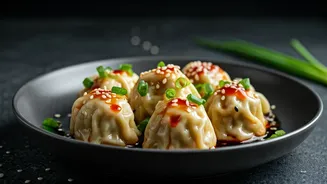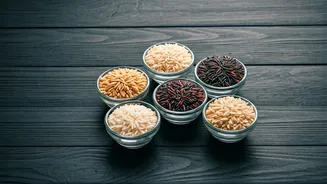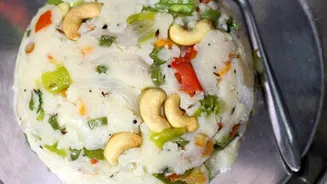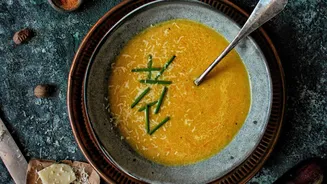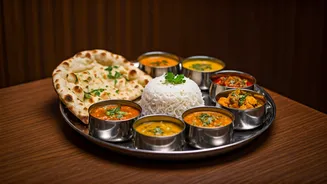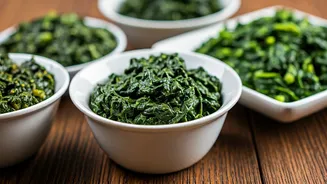Red Rice: Earthy Delight
Red rice, with its reddish-brown hue, stands out for its nutty flavor and slightly chewy texture. This rice variety is a powerhouse of nutrients, including
antioxidants, making it a healthy addition to any diet. Its appealing visual aspect and distinctive taste makes it a great substitute for regular white rice, adding both aesthetic and nutritional value to a meal. It cooks similarly to brown rice, requiring a bit more water and cooking time to achieve the desired tenderness. The slightly earthy flavor profile pairs well with savory dishes, and red rice is a fantastic base for salads and side dishes, adding a satisfying chewiness that complements various ingredients. Because of its fiber content, red rice is beneficial for digestive health, offering a fulfilling and beneficial meal. Its vibrant color is also an added advantage, enlivening any culinary presentation.
Black Rice: Antioxidant Power
Known as 'forbidden rice' due to its rarity and historical exclusivity to emperors, black rice offers a striking visual appeal and a host of health benefits. This type of rice turns a deep, dark purple when cooked, signaling its high concentration of anthocyanins, powerful antioxidants that have been linked to various health benefits. The rice has a slightly sweet, nutty flavor that works well in both sweet and savory applications. It's often found in Asian cuisine, and can be used in stir-fries, rice bowls, or even desserts. The texture is usually a bit chewier than white rice, and it retains its shape well after cooking, making it an attractive addition to dishes. The rich color and distinct flavor profile also make black rice a great way to add visual interest and nutritional value to any meal, enhancing both the taste and presentation.
Wild Rice: Unique Texture
Contrary to the name, wild rice isn't actually rice, but an aquatic grass seed. This grain is celebrated for its distinctive chewy texture and nutty flavor, providing a unique experience compared to other rice varieties. It adds an interesting element to dishes. It has a slightly earthy taste and is often used in salads, soups, and stuffings. Wild rice takes longer to cook than regular rice and offers an impressive nutritional profile, rich in fiber, protein, and antioxidants. Its dark color and elongated shape create a pleasant contrast, giving a delightful visual appeal to meals. This grain adds a touch of gourmet style to any dish. It's often paired with other grains or used as a substitute for rice, making it an excellent option for health-conscious eaters who want to include variety in their diet.
Purple Rice: Flavorful and Rich
Similar to black rice, purple rice showcases a deep purple hue and boasts a range of nutritional advantages. It is known for its subtly sweet, almost floral flavor and slightly sticky texture when cooked. The color comes from the presence of anthocyanins, making it rich in antioxidants. Purple rice has a satisfying mouthfeel and can be used as a versatile base for many meals. Whether in salads, rice bowls, or even desserts, purple rice lends both visual appeal and a rich flavor profile. Its natural sweetness often means you can use less added sugar in recipes, which is a big advantage for a healthy diet. This rice variety is often favored for those looking for a flavorful, healthful grain option that elevates everyday meals with its unique characteristics.
Bamboo Rice: Subtle Aroma
Bamboo rice is an exceptional variety, grown in the fertile valleys where bamboo naturally thrives. This rice typically has a light green or greenish-yellow tint, due to the way it is grown. Bamboo rice offers a subtle, delicate aroma and a unique, slightly chewy texture that distinguishes it from other rice types. Its mild flavor pairs well with a variety of dishes, and the visual characteristics make it an attractive option for presentation. The distinctive flavor lends a subtle earthiness to meals, which can be complemented by fresh herbs and light seasonings. Bamboo rice can be an excellent option for people who seek to diversify their culinary experiences. It's often associated with Asian cuisine and offers an interesting alternative to traditional rice varieties.
Kalijira Rice: Baby Basmati
Kalijira rice, also referred to as 'baby basmati', is a fine-grained, aromatic rice variant prized for its exceptional fragrance and delicate flavor. Smaller in size than typical basmati rice, Kalijira cooks quickly and has a light, fluffy texture. This rice is often used in special occasion dishes and is favored in many regional cuisines, particularly in the Indian subcontinent. The aroma is very appealing, adding a delightful layer to the cooking process. It is frequently employed in biryanis, pulaos, and other festive preparations, contributing a unique taste that elevates the overall dining experience. Its ability to absorb flavors also makes it a superb companion for curries, stews, and seasoned vegetables. Kalijira's small size, beautiful fragrance, and delightful taste make it an exceptional rice variety for those with refined tastes.
